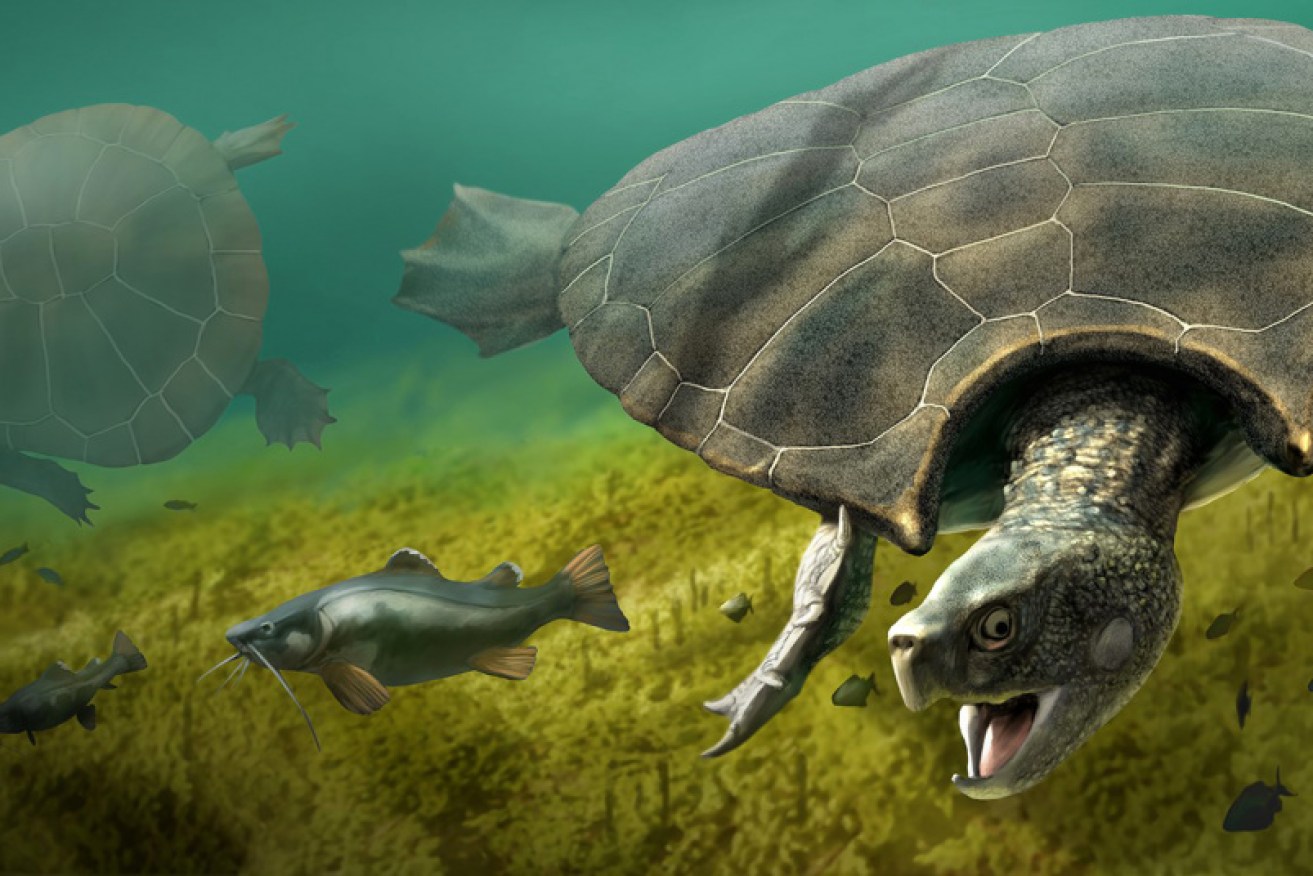Rampaging, not waddling: World’s biggest turtle 100 times bigger than modern slow-movers


Coming out of his shel: it would take a day or two for Stupendemys geographicus, the biggest and scariest turtle ever. Illustration: J.A. Chirinos
Beware reports of an ancient horned turtle the size of a car. It was more like the size of the flying saucer from the 1960s TV show My Favourite Martian.
The turtle – a freshwater species called Stupendemys geographicus that lived five to 10 million years ago – was first described in the 1970s.
Fossils at the time suggested the carapace (upper shell) grew to 1.85 metres.
However, paleobiologists from the University of Zurich (UZH) recently found even bigger high-quality specimens in Venezuela and Colombia. In these, the carapace ranged from 2.4 metres to nearly three metres.

Venezuelan palaeontologist Rodolfo Sánchez and a male carapace of Stupendemys geographicus found in eight-million-year-old deposits. Photo: Edwin Cadena
“The carapace of some Stupendemys individuals reached almost three metres, making it one of the largest, if not the largest turtle that ever existed,” says Dr Marcelo Sánchez, director of the Paleontological Institute and Museum of UZH and head of the study, in a prepared statement.
Stupendemysm is estimated to have had a body mass of 1145 kilograms – “almost 100 times that of its closest living relative, the big-headed Amazon river turtle”.
Stupendemys was a genus of pleurodira turtle, a type better known as a side-necked turtle.
They’re called side-necked turtles because their necks are so long, they need to be folded to one side to fit under the shell.
Not just big, but dangerous
The fossils were found in eight-million-year-old deposits.
The most surprising finding, on what were presumed to be male specimens, were a pair of horns on the anterior dorsal part of the carapace – think of them as curling out from the “shoulders” on either side of the turtle’s head.
“The two shell types indicate that two sexes of Stupendemys existed – males with horned shells, and females with hornless shells,” Dr Sánchez said.

Skull and lower jaw bones recovered in recent digs in South America. They showed evidence of being attacked by an ancient crocodile-like creature. Image: University of Zurich
He said this was the first time sexual dimorphism (males and females of a species look different from one another) “in the form of horned shells has been reported for any of the side-necked turtles, one of the two major groups of turtles worldwide”.
Interesting. But not as interesting as the fact the fossilised carapaces were covered in bite marks, and recovered bones were punctured.
The culprit was probably Purussaurus, the largest species of caimans, a kind of crocodile – and the turtle’s most likely predator.
The turtle thrived in a humid swampy region that today is a desert area in Venezuela.
According to the researchers, the region’s extinct fauna is unique, “as documented by fossils of giant rodents and crocodylians – including crocodiles, alligators, caimans and gavials”.
The researchers suggest Stupendemys geographicus had what is known as a durophagous diet, crushing hard-shelled prey such as molluscs.
But it also would have consumed fruits and acted as a seed disperser for many plant species.
Because the scientists discovered jaws and other skeleton parts of Stupendemys, they were able to thoroughly revise the evolutionary relationships of this species within the turtle tree of life.
“Based on studies of the turtle anatomy, we now know that some living turtles from the Amazon region are the closest living relatives,” Dr Sánchez said.
Furthermore, the new discoveries, published in Science Advances, and the investigation of existing fossils from Brazil, Colombia and Venezuela indicate a much wider geographic distribution of Stupendemys than previously assumed.
The animal lived across the whole of the northern part of South America.








